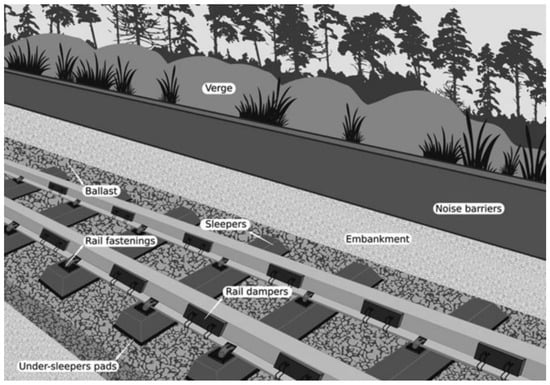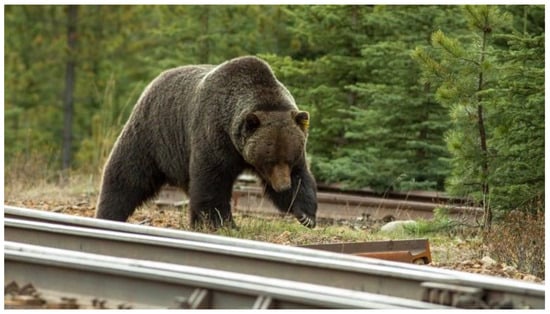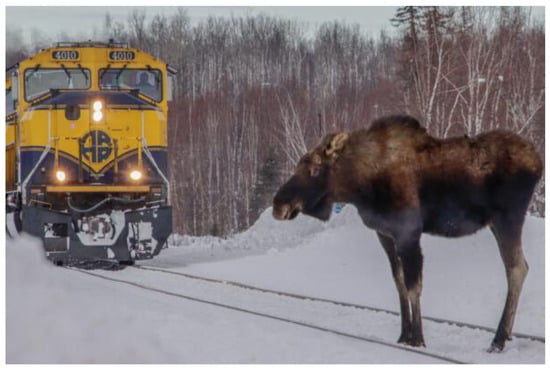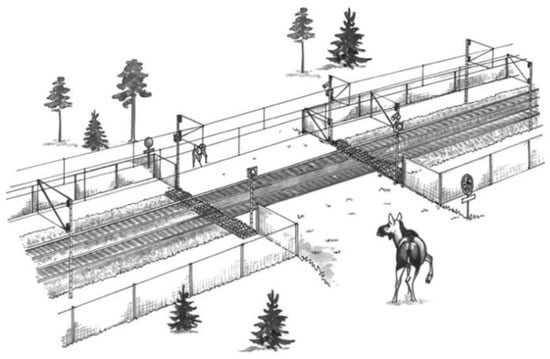
| Version | Summary | Created by | Modification | Content Size | Created at | Operation |
|---|---|---|---|---|---|---|
| 1 | Julia Milewicz | -- | 3541 | 2023-09-18 11:16:01 | | | |
| 2 | Sirius Huang | Meta information modification | 3541 | 2023-09-19 02:57:12 | | |
Video Upload Options
The development of railways stands as a pivotal milestone in the history of transportation, transforming the world and revolutionising the movement of people and goods. From their humble beginnings as rudimentary track systems to the sophisticated and interconnected networks we witness today, railways have played a crucial role in fostering economic growth, promoting globalisation, and shaping modern societies. Railways have long been recognised as one of the most environmentally friendly means of mass transit, offering lower carbon emissions, energy efficiency, and reduced congestion compared to other transportation modes. However, there are still many challenges to overcome to provide continuous sustainability in the context of environmental impacts, especially related to wildlife and habitat protection.
1. Noise Pollution

2. Emissions
3. Direct Threats to Wildlife




References
- Babisch, W.; Swart, W.; Houthuijs, D.; Selander, J.; Bluhm, G.; Pershagen, G.; Dimakopoulou, K.; Haralabidis, A.S.; Katsouyanni, K.; Davou, E.; et al. Exposure Modifiers of the Relationships of Transportation Noise with High Blood Pressure and Noise Annoyance. J. Acoust. Soc. Am. 2012, 132, 3788–3808.
- Smith, M.G.; Croy, I.; Ögren, M.; Hammar, O.; Lindberg, E.; Persson Waye, K. Physiological Effects of Railway Vibration and Noise on Sleep. J. Acoust. Soc. Am. 2017, 141, 3262–3269.
- Goines, L.; Hagler, L. Noise Pollution: A Modem Plague. South. Med. J. 2007, 100, 287–294.
- Selander, J.; Nilsson, M.E.; Bluhm, G.; Rosenlund, M.; Lindqvist, M.; Nise, G.; Pershagen, G. Long-Term Exposure to Road Traffic Noise and Myocardial Infarction. Epidemiology 2009, 20, 272–279.
- Wrótny, M.; Bohatkiewicz, J. Impact of Railway Noise on People Based on Strategic Acoustic Maps. Sustainability 2020, 12, 5637.
- International Union of Railways (UIC). Sustainability Nuisance and Health Impacts of Railway Noise—Noise and Vibration Technical Advice (NOVITÀ) Project; International Union of Railways (UIC): Paris, France, 2022; ISBN 978-2-7461-3209-2.
- Lucas, P.S.; de Carvalho, R.G.; Grilo, C. Railway Disturbances on Wildlife: Types, Effects, and Mitigation Measures. In Railway Ecology; Springer International Publishing: Cham, Switzerland, 2017; pp. 81–99.
- He, B.; Jin, X. Investigation into External Noise of a High-Speed Train at Different Speeds. J. Zhejiang Univ. Sci. A 2014, 15, 1019–1033.
- European Environment Agency. Environmental Noise in Europe, 2020; Publications Office: Luxembourg, 2020.
- Palacin, R.; Correia, J.; Zdziech, M.; Cassese, T.; Chitakova, T. Rail Environmental Impact: Energy Consumption and Noise Pollution Assessment of Different Transport Modes Connecting Big Ben (London, UK) and Eiffel Tower (Paris, FR). Transp. Probl. 2014, 9, 9–27.
- Fortea, P. Exploring Innovative Solutions for Reducing Railway Noise and Vibration Pollution. Available online: https://www.globalrailwayreview.com/article/92854/pedro-fortea-mafex-noise-vibrations/ (accessed on 16 July 2023).
- Thompson, D.; Jones, C. Noise and Vibration from the Wheel–Rail Interface. In Wheel–Rail Interface Handbook; Elsevier: Amsterdam, The Netherlands, 2009; pp. 477–509. ISBN 9781845696788.
- Komorski, P.; Szymanski, G.M.; Nowakowski, T.; Orczyk, M. Advanced Acoustic Signal Analysis Used for Wheel-Flat Detection. Lat. Am. J. Solids Struct. 2021, 18, 1–14.
- Ouakka, S.; Verlinden, O.; Kouroussis, G. Railway Ground Vibration and Mitigation Measures: Benchmarking of Best Practices. Railw. Eng. Sci. 2022, 30, 1–22.
- Croy, I.; Smith, M.G.; Waye, K.P. Effects of Train Noise and Vibration on Human Heart Rate during Sleep: An Experimental Study. BMJ Open 2013, 3, e002655.
- Maclachlan, L.; Waye, K.P.; Pedersen, E. Exploring Perception of Vibrations from Rail: An Interview Study. Int. J. Environ. Res. Public. Health 2017, 14, 1303.
- Thompson, D.J.; Gautier, P.-E. Review of Research into Wheel/Rail Rolling Noise Reduction. Proc. Inst. Mech. Eng. F J. Rail Rapid Transit. 2006, 220, 385–408.
- Nowakowski, T.; Firlik, B.; Staśkiewicz, T. Developing Assumptions for the Tram Noise Attenuation Passive System Using the Noise Maps Analysis Method. Arch. Acoust. 2023, 44, 783–792.
- Milewicz, J.; Mokrzan, D.; Nowakowski, T.; Szymański, G.M. Using the MIMO Method to Evaluate the Modal Properties of the Elements of a Wheelset in an Active Experiment. Vib. Phys. Syst. 2022, 33, 2022324.
- Liepert, M.; Möhler, U.; Schreckenberg, D.; Schuemer, R. The Impact of Rail Grinding on Noise Levels and Residents’ Noise Responses–Part I: Study Design and Acoustical Results. In Proceedings of the Inter-Noise Congress, Innsbruck, Austria, 15–18 September 2013; pp. 15–18.
- Lakuši, S.; Ahac, M.; Haladin, I. Experimental Investigation of Railway Track with under Sleeper Pad. In Proceedings of the 10th Slovenian Road and Transportation Congress, Ljubjana, October 2010; pp. 386–393.
- Zuo, C.; Birkin, M.; Clarke, G.; McEvoy, F.; Bloodworth, A. Reducing Carbon Emissions Related to the Transportation of Aggregates: Is Road or Rail the Solution? Transp. Res. Part A Policy Pract. 2018, 117, 26–38.
- International Union of Railways (UIC). 2022 Global Rail Sustainability Report; International Union of Railways (UIC): Paris, France, 2023.
- Lawrence, M.; Bullock, R. The Role of Rail in Decarbonizing Transport in Developing Countries; World Bank: Washington, DC, USA, 2022.
- Kim, M.-K.; Park, D.; Kim, M.; Heo, J.; Park, S.; Chong, H. A Study on Characteristic Emission Factors of Exhaust Gas from Diesel Locomotives. Int. J. Environ. Res. Public. Health 2020, 17, 3788.
- Cheng, Y.-H.; Yan, J.-W. Comparisons of Particulate Matter, CO, and CO2 Levels in Underground and Ground-Level Stations in the Taipei Mass Rapid Transit System. Atmos. Environ. 2011, 45, 4882–4891.
- Abbasi, S.; Jansson, A.; Sellgren, U.; Olofsson, U. Particle Emissions from Rail Traffic: A Literature Review. Crit. Rev. Environ. Sci. Technol. 2013, 43, 2511–2544.
- Mulley, C.; Hensher, D.A.; Cosgrove, D. Is Rail Cleaner and Greener than Bus? Transp. Res. D Transp. Environ. 2017, 51, 14–28.
- Kamińska, M.; Rymaniak, Ł.; Lijewski, P.; Szymlet, N.; Daszkiewicz, P.; Grzeszczyk, R. Investigations of Exhaust Emissions from Rail Machinery during Track Maintenance Operations. Energies 2021, 14, 3141.
- Kamińska, M.; Kołodziejek, D.; Szymlet, N.; Fuć, P.; Grzeszczyk, R. Measurement of Rail Vehicles Exhaust Emissions. Combust. Engines 2022, 189, 10–17.
- Logan, K.G.; Nelson, J.D.; McLellan, B.C.; Hastings, A. Electric and Hydrogen Rail: Potential Contribution to Net Zero in the UK. Transp. Res. D Transp. Environ. 2020, 87, 102523.
- Ćwil, M.; Bartnik, W.; Jarzębowski, S. Railway Vehicle Energy Efficiency as a Key Factor in Creating Sustainable Transportation Systems. Energies 2021, 14, 5211.
- Lai, Y.-C.; Barkan, C.P.L.; Önal, H. Optimizing the Aerodynamic Efficiency of Intermodal Freight Trains. Transp. Res. E Logist. Transp. Rev. 2008, 44, 820–834.
- González-Gil, A.; Palacin, R.; Batty, P.; Powell, J.P. A Systems Approach to Reduce Urban Rail Energy Consumption. Energy Convers. Manag. 2014, 80, 509–524.
- Benítez-López, A.; Alkemade, R.; Verweij, P.A. The Impacts of Roads and Other Infrastructure on Mammal and Bird Populations: A Meta-Analysis. Biol. Conserv. 2010, 143, 1307–1316.
- Chen, H.L.; Koprowski, J.L. Barrier Effects of Roads on an Endangered Forest Obligate: Influences of Traffic, Road Edges, and Gaps. Biol. Conserv. 2016, 199, 33–40.
- Popp, J.; Hamr, J. Seasonal Use of Railways by Wildlife. Diversity 2018, 10, 104.
- Barrientos, R.; Ascensão, F.; Beja, P.; Pereira, H.M.; Borda-de-Água, L. Railway Ecology vs. Road Ecology: Similarities and Differences. Eur. J. Wildl. Res. 2019, 65, 12.
- Coffin, A.W. From Roadkill to Road Ecology: A Review of the Ecological Effects of Roads. J. Transp. Geogr. 2007, 15, 396–406.
- Dorsey, B.; Olsson, M.; Rew, L.J. Ecological Effects of Railways on Wildlife. In Handbook of Road Ecology; John Wiley & Sons, Ltd.: Chichester, UK, 2015; pp. 219–227.
- Romanowski, J. Korytarze i Lacznosc Siedlisk w Ekologii i Ochronie Przyrody. Wiadomości Ekol. 2008, 2, 67–78.
- Kowal, P.; Jasińska, K.; Babinska-Werka, J. Active Animal Protection Methods along Railway Lines on European Ecological Network Natura 2000. Sci. Rev. Eng. Environ. Sci. 2013, 22, 463–471.
- Ito, T.Y.; Miura, N.; Lhagvasuren, B.; Enkhbileg, D.; Takatsuki, S.; Tsunekawa, A.; Jiang, Z. Preliminary Evidence of a Barrier Effect of a Railroad on the Migration of Mongolian Gazelles. Conserv. Biol. 2005, 19, 945–948.
- Kornilev, Y.V.; Price, S.J.; Dorcas, M.E. Between a Rock and a Hard Place: Responses of Eastern Box Turtles (Terrapene Carolina) When Trapped Between Railroad Tracks. Herpetol. Rev. 2006, 37, 145–148.
- Fahrig, L. Effects of Habitat Fragmentation on Biodiversity. Annu. Rev. Ecol. Evol. Syst. 2003, 34, 487–515.
- Kušta, T.; Ježek, M.; Keken, Z. Mortality of Large Mammals on Railway Tracks. Sci. Agric. Bohem. 2011, 42, 12–18.
- Bhattacharya, M.; Primack, R.B.; Gerwein, J. Are Roads and Railroads Barriers to Bumblebee Movement in a Temperate Suburban Conservation Area? Biol. Conserv. 2003, 109, 37–45.
- Jaeger, J.A.G.; Bowman, J.; Brennan, J.; Fahrig, L.; Bert, D.; Bouchard, J.; Charbonneau, N.; Frank, K.; Gruber, B.; von Toschanowitz, K.T. Predicting When Animal Populations Are at Risk from Roads: An Interactive Model of Road Avoidance Behavior. Ecol. Model. 2005, 185, 329–348.
- Waller, J.S.; Servheen, C. Effects of Transportation Infrastructure on Grizzly Bears in Northwestern Montana. J. Wildl. Manag. 2005, 69, 985–1000.
- Gilhooly, P.S.; Nielsen, S.E.; Whittington, J.; St. Clair, C.C. Wildlife Mortality on Roads and Railways Following Highway Mitigation. Ecosphere 2019, 10, e02597.
- Derworiz, C. Trains Travelling through Those National Parks Kill almost 30 Animals a Year. Available online: https://www.cbc.ca/news/canada/calgary/train-speed-death-wildlife-study-1.5822610 (accessed on 8 September 2023).
- Belant, J.L. Moose Collisions with Vehicles and Trains in Northeastern Minnesota. Alces A J. Devoted Biol. Manag. Moose 1995, 31, 45–52.
- Krauze-Gryz, D.; Żmihorski, M.; Jasińska, K.; Kwaśny, Ł.; Werka, J. Temporal Pattern of Wildlife-train Collisions in Poland. J. Wildl. Manag. 2017, 81, 1513–1519.
- Jasińska, K.D.; Bijak, S.; Child, K.N.; Rea, R.V. Temporal Patterns of Moose-Train Collisions in British Columbia—Implications for Mitigation. Sylwan 2020, 164, 32–40.
- Treinen, L. Hungry, Angry and Aggressive Moose Put Mushers on High Alert before Iditarod. Available online: https://alaskapublic.org/2022/03/03/hungry-angry-and-aggressive-moose-put-mushers-on-high-alert-before-iditarod/ (accessed on 12 July 2023).
- Malo, J.E.; García de la Morena, E.L.; Hervás, I.; Mata, C.; Herranz, J. Uncapped Tubular Poles along High-Speed Railway Lines Act as Pitfall Traps for Cavity Nesting Birds. Eur. J. Wildl. Res. 2016, 62, 483–489.
- Bartoszek, D.; Stolarski, M. Kolizje Pojazdów Szynowych Ze Zwierzętami a Bezpieczeństwo Ruchu Pociągów. Pr. Nauk. Politech. Warszawskiej. Transp. 2013, 96, 49–58.
- Milewicz, J.; Mokrzan, D.; Szymański, G. Methods to Reduce Wildlife Collisions with Rail Vehicles. Rail Veh. 2021, 3, 30–43.
- Backs, J.A.J.; Nychka, J.A.; St. Clair, C.C. Warning Systems Triggered by Trains Could Reduce Collisions with Wildlife. Ecol. Eng. 2017, 106, 563–569.
- Seiler, A.; Olsson, M. Wildlife Deterrent Methods for Railways—An Experimental Study. In Railway Ecology; Springer International Publishing: Cham, Switzerland, 2017; pp. 277–291.
- Shimura, M.; Ushiogi, T.; Ikehata, M. Development of an Acoustic Deterrent to Prevent Deer-Train Collisions. Q. Rep. RTRI 2018, 59, 207–211.
- Iuell, B. Wildlife and Traffic-a European Handbook for Identifying Conflicts and Designing Solutions. In Proceedings of the XXIInd PIARC World Road Congress, Durban, South Africa, 19–25 October 2003; World Road Association (PIARC): Paris, France, 2003.




